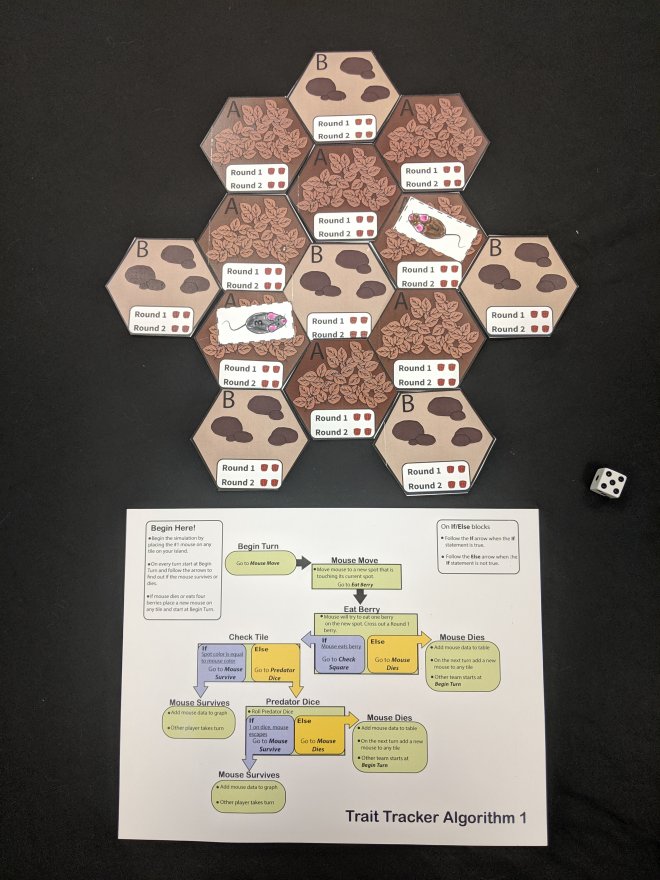Trait Tracker
Trait Tracker
The Smithsonian Science for Makerspaces: Trait Tracker explores how the environment affects the traits organisms develop. Using computational thinking and system models, students will obtain data and uncover patterns related to how characteristics can influence an animal’s success in an environment.
Class periods: 1-2
Preparation time: 40 minutes
Vocabulary Words: inherited, offspring, predator, trait
Downloads:
![]()
Download instructions for teachers
Spanish translations for the Smithsonian Science for Makerspaces challenges are made possible by a grant from the Smithsonian Women’s Committee.
Student Objectives:
- Obtain data to investigate how the environment affects the development of traits in organisms.
- Use an algorithmic model to uncover a pattern of how differences in characteristics affect an animals' changes of survival.
Diciplinary Core Ideas:
- Sometimes the differences in characteristics between individuals of the same species provide advantages in surviving, finding mates, and reproducing. (3-LS4-2)
- The environment affects the traits that an organism develops. (3-LS3-2)
Science and Engineering Practices
- Computational thinking
- Analyzing and interpreting data
Crosscutting Concepts
- Patterns
- Systems and system models
The teacher will share the following passage and images with students:
How are the baby bunnies in this picture similar? How are the baby bunnies different?Even though these animals are all the same species they can have different traits, like body size and fur color.
Sometimes a special trait can help an animal be more successful in their environment. Traits can help an animal eat new foods or better hide from predators. This wood mouse has a dark brown coat and lives on the forest floor. Its coat color helps it hide among the fallen leaves and sticks. Would it be easier or harder to survive if these mice had fur the color of the bunnies?

Image Credit: Litvalifa/iStock/Getty Images Plus
Click here to open image in a new window
 Image Credit: 1157909/Pixabay
Image Credit: 1157909/Pixabay
Click here to open image in a new window
Where do animals get their traits? Most traits are passed from parents to their offspring, or babies. If the trait is useful it will help an animal survive and give it a better chance to reproduce. But a trait that is not helpful in the environment makes it harder for the animal to survive and reproduce. Over many, many years there will be more animals with the helpful trait and fewer animals with the unhelpful trait. The environment and traits of the animal must be a good match.
Discussion Questions:
- Can you think of some other species of animals that have traits that are different from each other?
- What is an example of a good match between an animal trait and its environment? For example, the long neck of the giraffe helps it reach food in the trees.
Smithsonian Connections:
Explore more than 250 varieties of mammals and how their environment affects their traits at the Smithsonian Natural History Museum. https://naturalhistory.si.edu/exhibits/kenneth-e-behring-family-hall-mammals
The teacher will:
- Separate the class into groups of two or four students each.
- Print one copy of the Example Islands worksheet, Trait Tracker Algorithm 1 worksheet, Trait Tracker Algorithm 2 worksheet, and the three sheets with mice, shelters, and Team A and Team B island tiles for each student group.
- Print one copy of the Trait Tracker: Design It! worksheet and the Trait Tracker: Test It! worksheet for each individual student.
- Provide each student group with the following materials:
Markers or crayons
Scissors
1 Dice
Student groups will:
- Separate into two teams, A and B. Team A will color the Team A island tiles and Team A mice one color. Team B will color the Team B island tiles and Team B mice a different color.
- Students will cut out the tiles, shelters, and mice from their worksheet packet.
- Students will write their name and their team letter on the Design It! and Test It!worksheets.
Maker Tips
- For more sturdy simulation pieces, use cardstock instead of paper.
- Student groups can tape island pieces to their desk to keep them from shifting.
- Using the island tiles from both Team A and Team B, student groups will build an island game board.
- No Team B tiles can be touching on the island game board. See the Example Islands worksheet for an example.
- Introduce the Trait Tracker Algorithm 1 and 2 worksheets as a step-by-step way to work through the mouse simulation. “This is an example of an algorithm. An algorithm is a step-by-step process computers use to solveproblems.”
- Students will work through the simulation, starting with the Trait Tracker Algorithm 1, Begin Here! directions.
- As student groups complete their turns, they will record how many berries each mouse ate on their Design It! worksheet data table.
- Teams will replace their mouse if it dies or if it collects four berries. Each team will have five mice total. The data table is complete when details have been added for each team’s five mice.
- After the data table has been completed, individual students will answer the questions on the Design It! worksheet.
- Combine student groups together for a class discussion to share their answers to the Design It! questions.
- Give student groups the new goal of working together to try to help the Team B mice survive longer.
- Student groups will read through Trait Tracker Algorithm 2, starting at the Begin Here! directions. Before starting the simulation, students will need to place three shelters in locations that would be beneficial to the Team B mice.
- Student will work through the simulation again using Trait Tracker Algorithm 2.
- Students will record how many berries each mouse ate on their Test It! worksheet data tables.
- After the data table has been completed, individual students will answer the questions on the Test It! worksheet.
- Combine student groups for a class discussion to share their answers to the Test It! questions.
